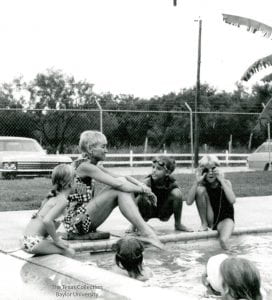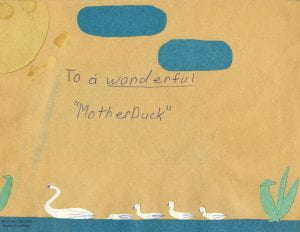This post was written by Ella Hadacek. Ella is a Master’s Candidate in the Department of History; this is her first year working at The Texas Collection. She recently completed processing the Margaret M. Swan Synchronized Swimming papers and wanted to share Swan’s story as we close Women’s History Month.

Margaret Swan, a San Antonio native, coached the Cygnets, an all-girls synchronized swimming team for fourteen years. Under her “dictatorship,” the team won nine Junior National Championships, enduring hours of daily practice under her strict supervision.2 The team loved her for her dedication to their success, affectionately calling her “Mother Duck.” Swan’s personal papers, which reside at The Texas Collection, include countless letters and cards addressed to Mother Duck and drawings of ducks given to Swan on her birthday.
Margaret Swan always intended to pursue work in athletics. She received her bachelor’s and master’s degrees in physical education from Trinity University, and she even started doctoral work at the University of Texas at Austin in the 1960s.3 The mother of four never finished her dissertation. Instead, she turned her passionate work ethic to synchronized swimming while continuing to teach at San Antonio College.

In 1963, Swan cut ties with the Silver Fins under unpleasant circumstances that, at the time, she called beyond her control.4 She later told Sports Illustrated that the split happened “because of parental interference.” After the split, Swan and her first husband, George, built an in-ground pool to coach synchronized swimming, and so was born the Cygnets—a word that means “little swan.”5
Swan, who was named Sportswoman of the Year by the San Antonio Express and News in 1973, not only carried her team to success at competitions in the United States, but she also took them to events in Czechoslovakia, Mexico, Canada, England, Germany, France and Denmark. Swan’s Cygnets even played a part in the Cold War. In 1976, a Trinity University newsletter celebrated that two of their students, part of the Cygnets, would be traveling to Czechoslovakia to demonstrate their “winning techniques” in Eastern Europe.
“Rumors have it that the Russians will be at the meet to view the demonstrations.
The United States and other Western countries have been urging that
synchronized swimming be added to Olympic competition.
According to rumors, the Russians want to see if they can compete.”6

Swan announced her impending retirement in 1977. She received a flurry of letters asking her to reconsider the decision. One correspondent wrote, “Synchro will not be the same without our favorite ‘duck’ around.”9 Swan, who married sportswriter Harry Forbes in 1979, retired from coaching the Cygnets, but she didn’t abandon the sport. In 1984, she wrote the first book on synchronized swimming, Coaching Synchronized Swimming Effectively. Swan also served on the Synchronized Swimming Olympic-International Committee for two decades, including as secretary and chairwoman.10 In 1984, Vogue called Swan “the woman who succeeded in a thirty-year effort to get synchronized swimming into the Olympics.”
Women like Swan transformed synchronized swimming, popularized in Hollywood films starring Esther Williams, into a serious and respected sport. Through their work, Synchronized Swimming (now Artistic Swimming) grew in popularity in the United States in the 1950s and was officially recognized as an Olympic sport in 1984.11






No Comments